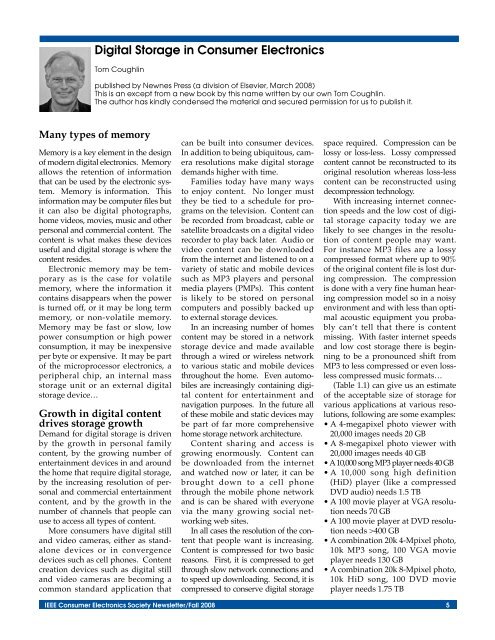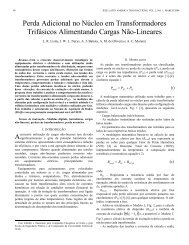continued from page 1 - IEEE Entity Web Hosting IEEE Entity Web ...
continued from page 1 - IEEE Entity Web Hosting IEEE Entity Web ...
continued from page 1 - IEEE Entity Web Hosting IEEE Entity Web ...
You also want an ePaper? Increase the reach of your titles
YUMPU automatically turns print PDFs into web optimized ePapers that Google loves.
Many types of memory<br />
Digital Storage in Consumer Electronics<br />
Tom Coughlin<br />
published by Newnes Press (a division of Elsevier, March 2008)<br />
This is an except <strong>from</strong> a new book by this name written by our own Tom Coughlin.<br />
The author has kindly condensed the material and secured permission for us to publish it.<br />
Memory is a key element in the design<br />
of modern digital electronics. Memory<br />
allows the retention of information<br />
that can be used by the electronic system.<br />
Memory is information. This<br />
information may be computer files but<br />
it can also be digital photographs,<br />
home videos, movies, music and other<br />
personal and commercial content. The<br />
content is what makes these devices<br />
useful and digital storage is where the<br />
content resides.<br />
Electronic memory may be temporary<br />
as is the case for volatile<br />
memory, where the information it<br />
contains disappears when the power<br />
is turned off, or it may be long term<br />
memory, or non-volatile memory.<br />
Memory may be fast or slow, low<br />
power consumption or high power<br />
consumption, it may be inexpensive<br />
per byte or expensive. It may be part<br />
of the microprocessor electronics, a<br />
peripheral chip, an internal mass<br />
storage unit or an external digital<br />
storage device…<br />
Growth in digital content<br />
drives storage growth<br />
Demand for digital storage is driven<br />
by the growth in personal family<br />
content, by the growing number of<br />
entertainment devices in and around<br />
the home that require digital storage,<br />
by the increasing resolution of personal<br />
and commercial entertainment<br />
content, and by the growth in the<br />
number of channels that people can<br />
use to access all types of content.<br />
More consumers have digital still<br />
and video cameras, either as standalone<br />
devices or in convergence<br />
devices such as cell phones. Content<br />
creation devices such as digital still<br />
and video cameras are becoming a<br />
common standard application that<br />
can be built into consumer devices.<br />
In addition to being ubiquitous, camera<br />
resolutions make digital storage<br />
demands higher with time.<br />
Families today have many ways<br />
to enjoy content. No longer must<br />
they be tied to a schedule for programs<br />
on the television. Content can<br />
be recorded <strong>from</strong> broadcast, cable or<br />
satellite broadcasts on a digital video<br />
recorder to play back later. Audio or<br />
video content can be downloaded<br />
<strong>from</strong> the internet and listened to on a<br />
variety of static and mobile devices<br />
such as MP3 players and personal<br />
media players (PMPs). This content<br />
is likely to be stored on personal<br />
computers and possibly backed up<br />
to external storage devices.<br />
In an increasing number of homes<br />
content may be stored in a network<br />
storage device and made available<br />
through a wired or wireless network<br />
to various static and mobile devices<br />
throughout the home. Even automobiles<br />
are increasingly containing digital<br />
content for entertainment and<br />
navigation purposes. In the future all<br />
of these mobile and static devices may<br />
be part of far more comprehensive<br />
home storage network architecture.<br />
Content sharing and access is<br />
growing enormously. Content can<br />
be downloaded <strong>from</strong> the internet<br />
and watched now or later, it can be<br />
brought down to a cell phone<br />
through the mobile phone network<br />
and is can be shared with everyone<br />
via the many growing social networking<br />
web sites.<br />
In all cases the resolution of the content<br />
that people want is increasing.<br />
Content is compressed for two basic<br />
reasons. First, it is compressed to get<br />
through slow network connections and<br />
to speed up downloading. Second, it is<br />
compressed to conserve digital storage<br />
space required. Compression can be<br />
lossy or loss-less. Lossy compressed<br />
content cannot be reconstructed to its<br />
original resolution whereas loss-less<br />
content can be reconstructed using<br />
decompression technology.<br />
With increasing internet connection<br />
speeds and the low cost of digital<br />
storage capacity today we are<br />
likely to see changes in the resolution<br />
of content people may want.<br />
For instance MP3 files are a lossy<br />
compressed format where up to 90%<br />
of the original content file is lost during<br />
compression. The compression<br />
is done with a very fine human hearing<br />
compression model so in a noisy<br />
environment and with less than optimal<br />
acoustic equipment you probably<br />
can’t tell that there is content<br />
missing. With faster internet speeds<br />
and low cost storage there is beginning<br />
to be a pronounced shift <strong>from</strong><br />
MP3 to less compressed or even lossless<br />
compressed music formats…<br />
(Table 1.1) can give us an estimate<br />
of the acceptable size of storage for<br />
various applications at various resolutions,<br />
following are some examples:<br />
• A 4-megapixel photo viewer with<br />
20,000 images needs 20 GB<br />
• A 8-megapixel photo viewer with<br />
20,000 images needs 40 GB<br />
• A 10,000 song MP3 player needs 40 GB<br />
• A 10,000 song high definition<br />
(HiD) player (like a compressed<br />
DVD audio) needs 1.5 TB<br />
• A 100 movie player at VGA resolution<br />
needs 70 GB<br />
• A 100 movie player at DVD resolution<br />
needs >400 GB<br />
• A combination 20k 4-Mpixel photo,<br />
10k MP3 song, 100 VGA movie<br />
player needs 130 GB<br />
• A combination 20k 8-Mpixel photo,<br />
10k HiD song, 100 DVD movie<br />
player needs 1.75 TB<br />
<strong>IEEE</strong> Consumer Electronics Society Newsletter/Fall 2008 5

















